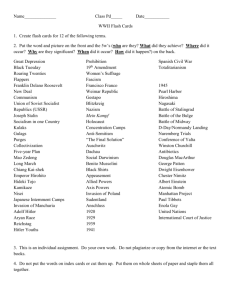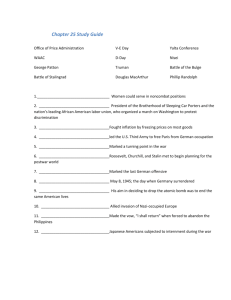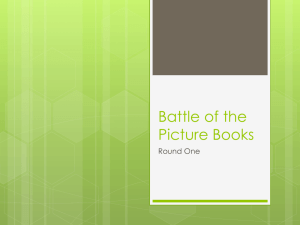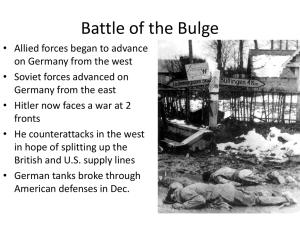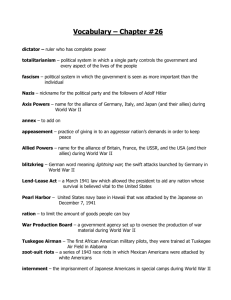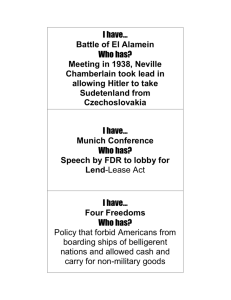World at War
advertisement
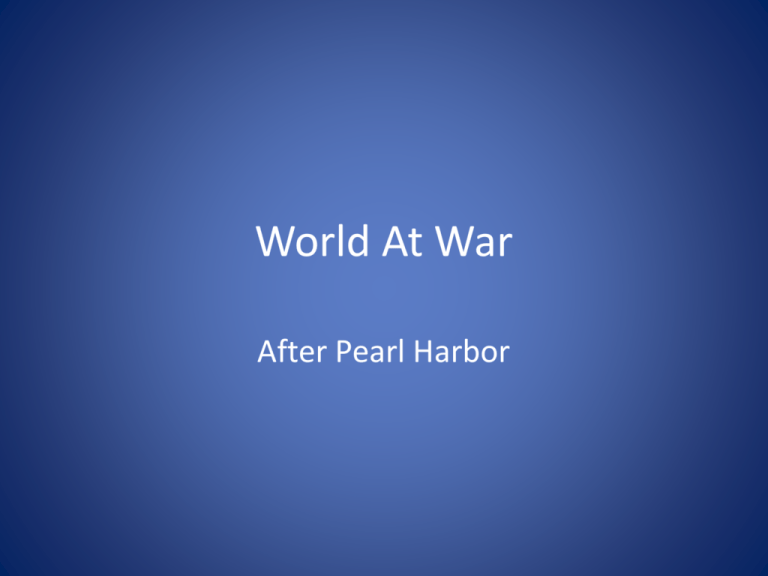
World At War After Pearl Harbor Battle of the Atlantic • Naval battle in the Atlantic Ocean between German Navy and the Allied forces of the British and United States • Purpose of Battle: – Allies were trying to keep shipping routes for supplies from the United States to Europe open – Germans wanted to sink all supply ships coming into England • Outcome: – Fought for many years but American ship building increased and gave convoys better support and U-boat hunting capabilities Siege/Battle of Stalingrad • Siege started in 1941 – from 1941 to 1942 nearly 1 million Russian perish from starvation • Battle of Stalingrad: – Started in May 1942 – Germany was trying to overrun one of the largest Russian cities and the main industrial city in the Russian war effort – Taking the city would stop food supplies across Russia as well – Considered the most brutal battle of the war • Outcome – Soviet fighters held off the German attack and under the command of Gregory Zhukov the forced a German surrender in late January 1943 – cost Soviets 1,000,000 soldiers Japanese Invasion of Philippines • When: December 8, 1941 - April 1942 • Who was Involved: – United States and Filipino Forces • Led by General Douglas MacArthur – Japanese forces • Results: – Japanese defeat the forces defending the island by outnumbering them 3 to 2. – Led to the Bataan Death March – march of the surrendering forces of the Philippines to prison camps on the Bataan Peninsula War in North Africa • Main Fighters: – Axis Powers = Afrika Corps • Led by Erwin Rommel – the Desert Fox – Allied Forces of Britain and U.S. • Led by: – General Bernard Montgomery – British commander – General Dwight D. Eisenhower – U.S. commander and supreme allied commander in Europe • Major Battle: Battle of El Alamein – British forces severely weaken the Afrika Corps, because they are poorly supplied • Outcome: – Allies take control of North Africa by 1943 forcing German and Italian forces back into Italy Battle of Coral Sea • When: May 1942 • Significance: Was the first naval battle involving Japanese and American Aircraft Carriers battling each other • Results: – Both sides suffer significant losses but the Americans suffered more. – However, this battle stopped the advance of the Japanese military Battle of Midway • When: June 1942 • Significance: – Japan wanted to take out a key American military base used in the war on Japan – Americans were outnumbered and outgunned by Japanese navy • Key leader: – Chester Nimitz – American admiral in control of the Pacific Fleet • Result: – Allies won a great victory destroying 4 Japanese carriers and U.S. now can go on the offensive in the Pacific Battle of Guadalcanal • When: Late 1942 until February 1943 – Start of the bloodiest battles in the Pacific • Significance: – This battle signifies a key strategy of the United States military in the Pacific – island hopping • Island hopping – involves skipping over Japanese strong holds in favor of less defended islands and then cutting off those strong holds from supplies – Guadalcanal gives the first example of how hard the Japanese will fight to hold on to land and begins to show U.S. how bloody the war could get in the future D-Day Invasion • • • • When: June 6, 1944 – This was also known as Operation Overlord Key Planners of the Invasion – George Marshall and Dwight Eisenhower Significance: – Created a much needed second front in Europe to put pressure on Germany – Allowed for a direct line from bases in England to European mainland Outcome: – Allies make landing and fight for control through July and August – By end of August 1944 – France is liberated Battle of Leyte Gulf • When: October 1944 • Significance: – Largest naval battle ever fought in the history of war – Saw the first use of Japanese kamikazes • Kamikazes – pilots who loaded their planes with explosives and flew them into American warships • Outcome: – Americans defeat the Japanese and Douglas MacArthur is able to retake control of the Philippines – Virtually destroyed the Japanese Navy Battle of the Bulge • When: December 1944 – January 1945 • Significance: – Last major offensive by Germans – Americans withstand the push and then crush the German advance • Outcome: – This defeat of Germany led to Americans being able to cross the Rhine River into German by March 1945 – Allowed for Allied forces to eventually surround Berlin Victory in Europe • Timeline: – April 1945 - Soviet Troops surround and begin shelling Berlin – May 2, 1945 – Soviet troops discover the body of Adolf Hitler laying dead near his bunker – May 7, 1945 – Germany surrenders to Allied forces – May 8, 1945 – Allies call it V-E Day officially ending six years of blooding war in Europe Battle of Iwo Jima • When: February 1945 – March 1945 • Significance: – U.S. needed bases closer to lessen the risk of trying to bomb mainland Japan • Results: – Americans suffered huge losses for such a small island – Americans got a sense that Japanese were going to fight to the death – First idea that Americans had of the cost of invasion of Japan – Created an iconic image – the Soldiers raising the flag on Mt. Suribachi Battle of Okinawa • When: April 1, 1945 – June 22, 1945 • Significance: – Gave Americans a base of operations 350 miles from Japan – Americans were forced to kill nearly 100,000 Japanese troops defending the island • Results: – This battle made it clear the cost of American lives in an invasion of Japan where they would have nearly 3 million defending the island – Clears way for the dropping of the Atomic Bomb option Dropping of the Atomic Bombs • • • • • American atomic bomb program was called the Manhattan Project Why did the U.S. make this decision? – Fear of the idea that Japanese would fight to the death – Early estimates saw that nearly 1,000,000 American troops could lose their lives in an invasion First bomb drop: – August 6, 1945 – dropped on the city of Hiroshima Second bomb drop: – August 9, 1945 – dropped on the city of Nagasaki Result: – Killed many innocent Japanese citizens, but led to an eventual surrender of Japan Victory in Japan • V-J Day – August 15, 1945 • After the dropping of the two atomic bombs: – Emperor Hirohito tells the world that Japan is utterly defeated – Japan signs the official surrender on the deck of the USS Missouri on September 2, 1945 Questions 1 of 4 • What was the purpose of the Battle of the Atlantic? • How did the Allies win the Battle of the Atlantic? • Who led the Russian troops to victory in the Battle for Stalingrad? • What did the Battle of Stalingrad accomplish? • Who was the leader of the Allied forces in the Philippines? • What was the Bataan Death March? Questions 2 of 4 • Who was the leader of the Afrika Corps? Who led the British forces in North Africa? • What was the outcome of the Battle of El Alamein? • What was the main outcome of the Battle of Coral Sea? • Who led the American Fleet at the Battle of Midway? Why was this battle a huge boost for Allied forces in the Pacific? Questions 3 of 4 • What is island hopping? What was the main battle that showed this American strategy? • Who planned the D-Day invasion? Why was this invasion needed? • What are kamikazes? What battle saw the first use of these by Japan? • Where was the German’s last offensive? Why was this battle’s outcome significant? • When did Germany surrender? What was the next day called? Questions 4 of 4 • What battle saw the iconic image of the U.S. soldiers taking Mount Suribachi? • What did the Americans come to realize with the battles of Okinawa and Iwo Jima? • What was the name of the American program to create the Atomic Bomb? • Which two Japanese cities saw the A-bomb dropped on them? • When did Japan surrender? When was the treaty officially signed and on what ship was it signed?


